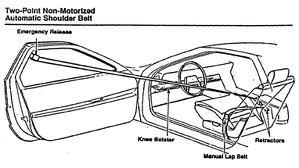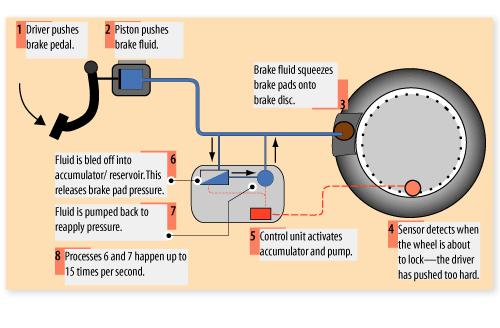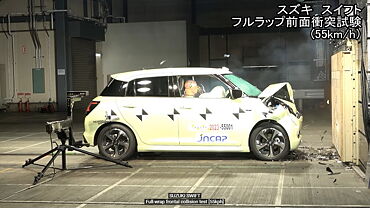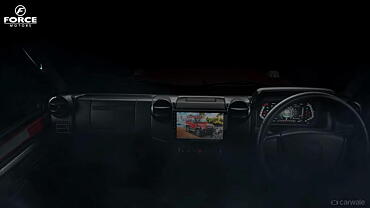Safety Systems and Security Features in cars
In earlier articles, we discussed different features of automobiles that make use of electronics. In this final article, we will be dealing with safety systems and security devices that are generally used in cars.
Safety Systems
Apart from the technology used in making of body shells, pillars, doors etc. in a car in order to provide the best of strength and safety to the passengers, some other features that can be listed under this category of safety include seat belts, anti lock brake, airbags etc. These systems make use of the car’s electronic systems.
Seat belts
In the seat belt system, which protects you in the event of a sudden stop, there are two types. First, there is the active restraint system, in which the occupants must make a manual effort to secure it. Indeed, in most of the vehicles the passenger must fasten the seat belts himself for crash protection. However, there is also a passive restraint system which operates automatically. No action is required by the passenger to operate the same.

A passive seat belt system uses electric motors to automatically move the shoulder belt across the driver and front seat passenger. The upper end of belt is attached to a carrier that moves in a track at the top of the door frame. The other end is fixed to lock retractor. The retractors are mounted in center console. When the door is opened, the outer end of the shoulder belt moves forward to allow for easy entry or exit. When doors are closed and ignition is on, the belts move in the reverse direction and secure occupants.
Airbags
In spite of securing passenger with seat belts, during a collision of a car at high speed, strong inertia forces develop due to which the passenger moves forward at high speed and chances of the driver hitting the steering wheel (and for the co-driver to the dashboard) are substantial. Moreover, in the case of collision, the harm to face and head of the person is most dangerous. To avoid the direct impact airbags are used for securing the occupants. Technically, airbag is a passive restraint system as it operates automatically to provide additional safety for the passenger.

Working of airbags
Generally, an airbag does not operate under low intensity impacts. Once the impact exceeds a specified limit and this force is detected by the airbag activation sensors, the switch contacts of the airbag activation circuit are closed and within milliseconds nitrogen gas is produced from the chemical reaction of Sodium Azide (NaNO3) and Potassium nitrate (KNO3). The nitrogen gas inflates the airbag, which is generally made up of Nylon fabric. The inflated airbag thus gives cushioning effect to the passenger.
It is to be noted that once the airbag is activated, then the same cannot be reused and it needs to be refitted at the production plant.
The same working principle as above is applicable for airbags located at different locations such as pillars, passenger side, curtains etc. Obviously, the more airbags, the higher would be the price.
Antilock brake system
When a vehicle is driven on slippery surfaces and brakes are applied forcefully, there are chances that the tyres stop rotating, causing slidding. This happens due to temporary locking of brakes after continuous application of brakes. To avoid such locking, there exists an anti locking system for brakes, the ABS.
Working of ABS
The antilock braking system control circuit calculates slip rate of wheels and controls brake fluid pressure. If the control sensor senses that a wheel is about to lock based on input sensor data, it pulses the brake fluid valve for that circuit to closed position. This prevents any more fluid from entering the brake circuit and limits the braking power. (Remember that a car brake works due to pressure being applied by braking fluid.)
The ABS control module then looks at sensor signal from the affected wheel again. If that wheel is decelerating faster than the other three wheels, it opens a normally closed outlet solenoid valve for that circuit, allowing fluid to leak away to an accumulator. This removes any pressure that is trapped between the closed inlet valve and brake back to the master cylinder reservoir, so that braking power is further reduced on that wheel. Once the affected wheel returns to the same speed as the other wheel, the control circuit returns the valve to their normal condition allowing fluid flow to affected brake.

source: How Things Work?
Security and anti-theft systems
Since their launch, thieves have tried to take off with cars in order to resell them or even just for joyrides. As a result, anti-theft systems have become very important.
There are three types of antitheft devices, i.e. locking devices, the disabling device, and alarm systems. Many of these devices are available as original equipment from manufacturers but some can be installed from the open market.
Locks
A variety of locks are available that are designed to deny entry to engine, passenger and trunk compartments of the car as well as to prevent theft of the car. Locking systems include door and trunk locks, keyless entry systems, fuel tanks, light delay systems, and electronically coded keys.
There are both internal and external hood locks available to prevent theft of anything under bonnet. These locks are especially useful on a vehicle with battery powered alarm systems because they prevent a thief from disconnecting power source and disabling siren.

Keyless entry systems
Keyless entry systems allow the driver to unlock a lock from the outside of the vehicle without using key. The electronic circuit can unlock all doors, the luggage compartment, lock all doors and trunk lid, activate key pad and keyhole illumination after any button on the keypad is pushed.
It has two main components: a electronic circuit with receiver in the car and a coded button on keypad of the key.
Remote keyless entry systems use a hand held transmitter, frequently attached as part of key handle. With a press of button on the transmitter, the driver’s door unlocks and the theft security system is disconnected depending upon type of transmitter.
Some remote units can also open and close all of vehicle’s windows including sunroof. They may also be capable of setting off alarm in case of emergency.
Pass key systems
The pass key is a specially designed key that is fitted with a resistor, transistor, or a transponder that is selected and programmed for the vehicle it was intended for. Although another key may fit into the ignition switch or door lock, the system will not allow the engine to start without correct electrical signal from the key. The ignition lock reads the electronic coding on the key. Without proper key coding, the engine does not start.
Disabling device
A disabling device deactivates the car’s and renders it immobile. A disabling device can either be active or passive. Active units are controlled by either a key, coded sequence, digital touch pad, or a hidden button mounted under the dash. Passive systems are part of the anti-theft system.
Alarm systems
Alarm systems cause a warning when a car is being accessed in a way other than use of key. The two types of activating alarm system are passive and active systems. Passive systems switch on automatically when ignition key is removed and doors are locked. Active systems are activated manually with a key pad or toggle switch. This allows the driver to leave the car at a parking without activating the alarm. The disadvantage is that one must remember to turn the alarm on or off.
There are three ways through which an alarm system identifies occurrence of theft.
Among devices used for alarm systems, mechanical switches are similar to those used to turn on the courtesy lights as the doors are opened. When a door or hood or trunk is opened while the alarm is active, the switch closes and the alarm sounds. It turns itself off automatically to prevent the battery from being drained. It then rearms itself automatically.
Ultrasonic sensors are movement or vibration based sensors. They sound an alarm if someone tries to enter the car either through door or window.
Current sensitive sensors activate the alarm if change in current occurs within car’s electrical systems. When a courtesy light goes on or ignition starts, the alarm is activated. However it might not be practical to use this type of sensor in a car in which light does not turn on when back doors are opened.
Vehicle tracking systems
Vehicle tracking systems can trace the location of the vehicle by satellite if it has been stolen or lost. The system can be based on vehicle’s navigation system or cellular phone inside the car.
When the car phone is the identifier, the tracking system is activated when the thief attempts to make a call. If correct code is not entered, the satellite begins to track the vehicle. Later, it is monitored by operator.
Some systems automatically send signal to tracking operator if airbag is activated. This signal addition to the global positioning network, lets the authorities to know if an accident has occurred and emergency squad can be sent without waiting for phone call.
Conclusion
In cars, there are numerous features varying from car to car and depending upon the cost of car and its intended utility. Today we have discussed electronics features pertaining to safety (ABS, airbags, seat belts) and security (locks, disabling systems, trackers and alarms.)
Apart from knowing the functioning of the various components of vehicles, the maintenance requirement of each system is also important. We would take up the matter in an upcoming article.



























